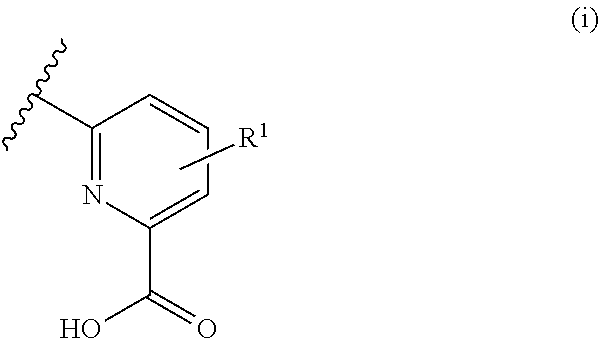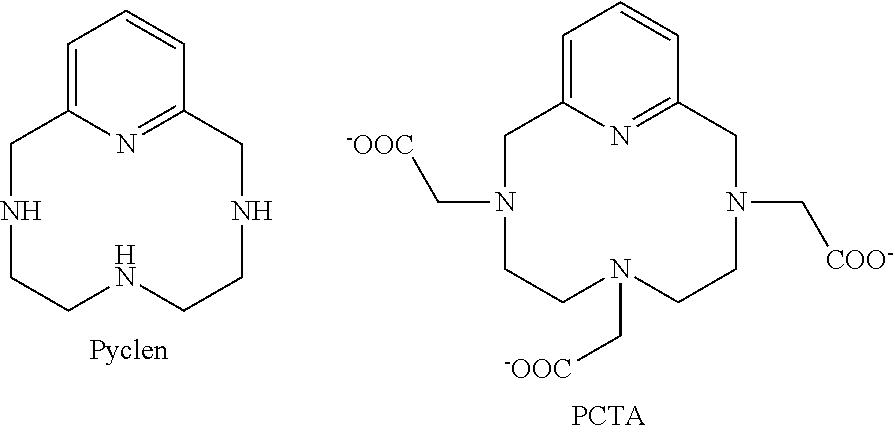Pyclen-based macrocyclic ligands, chelates thereof and uses thereof
a macrocyclic ligand and pyclen technology, applied in the field of pyclen, can solve the problems of insufficient complexation strength, limitations of existing complexes, and inability to achieve the effect of reducing the number of complexes
- Summary
- Abstract
- Description
- Claims
- Application Information
AI Technical Summary
Benefits of technology
Problems solved by technology
Method used
Image
Examples
example 1
of Ligands According to the Invention
General Methods
[0241]Analytic HPLC was performed on a Prominence Shimadzu HPLC / LCMS-2020 equipped with a UV SPD-20 A detector. The chromatographic system employs HPLC (Vision HT C18 HL 5 μ 250×4.6 mm) with H2O and MeCN as eluents [isocratic 100% H2O (5 min), linear gradient from 0 to 90% MeCN (10 min), isocratic 90% MeCN (5 min)] at a flow rate of 1 mL / min and UV detection at 254 and 350 nm. NMR spectra were recorded at the “Services communs” of the University of Brest. 1H and 13C NMR spectra were recorded using Bruker Avance 500 (500 MHz), Bruker Avance 400 (400 MHz), or BrukerAMX-3 300 (300 MHz) spectrometers. HRMS analyses were realized on a HRMS Q-Tof MaXis, sources ESI, APCI, APPI, nano-ESI (at the Institute of Organic and Analytic Chemistry [ICOA] in Orléans).
General Materials
[0242]Reagents were purchased from ACROS Organics and from Aldrich Chemical Co and used without further purification, except pyclen (I1) purchased from Glixx Laborator...
example 1-1
f Ligand S1
[0244]
Methyl 4-((4-(2-(2-(2-methoxyethoxy)ethoxy)ethoxy)phenyl)ethynyl)-6-(((methylsulfonyl)oxy)methyl)picolinate (I5)
[0245]
was synthesized as previously described (Walton, J. W., et al., Chemical Communications, 2013, Vol. 49, No. 16, pp. 1600-1602).
Synthesis of dimethyl 6,6′-((9-(2-methoxy-2-oxoethyl)-3,6,9-triaza-1(2,6)-pyridinacyclodecaphane-3,6-diyl)bis(methylene))bis(4-((4-(2-(2-(2-methoxyethoxy)ethoxy)ethoxy)phenyl)ethynyl)picolinate) (E1)
[0246]A solution of compound I4 (106 mg, 0.38 mmol) and K2CO3 (211 mg, 1.52 mmol, 4 eq) in CH3CN (9.5 mL) was stirred at room temperature for 30 min. To this solution was added dropwise a solution of mesylated antenna I5 (396 mg, 0.78 mmol, 2.05 eq) in CH3CN (14 mL). The reaction mixture was stirred at room temperature for 15 h and solvents were evaporated to dryness. The residue was taken up in CH2Cl2 and the residual salts were filtered on celite. Solvents were evaporated to dryness and the crude was purified by chromatography o...
example 1-2
f Ligand S2
[0249]
Methyl 4-((4-(bis(2-(2-(2-methoxyethoxy)ethoxy)ethyl)amino)phenyl)ethynyl)-6-(((methylsulfonyl)oxy)methyl)picolinate (I6)
[0250]
was synthesized as previously described (D'Aléo, A. et al., Angewandte Chemie International Edition, 2012, Vol. 51, pp. 6622-6625.).
Synthesis of dimethyl 6,6′-((9-(2-methoxy-2-oxoethyl)-3,6,9-triaza-1(2,6)-pyridinacyclodecaphane-3,6-diyl)bis(methylene))bis(4-((4-(bis(2-(2-(2-methoxyethoxy)ethoxy)ethyl)amino)phenyl)ethynyl)picolinate) (E2)
[0251]A solution of compound I4 (92 mg, 0.33 mmol) and K2CO3 (183 mg, 1.32 mmol, 4 eq) in CH3CN (8.3 mL) was stirred at room temperature for 30 min. To this solution was added dropwise a solution of the mesylated antenna I6 (442 mg, 0.68 mmol, 2.05 eq) in CH3CN (12.3 mL). The reaction mixture was stirred at room temperature for 15 h and at 55° C. for 2 days before addition of 0.14 eq of the mesylated antenna I6. The reaction mixture was stirred at 55° C. for one more day and solvents were evaporated to dryne...
PUM
 Login to View More
Login to View More Abstract
Description
Claims
Application Information
 Login to View More
Login to View More - R&D
- Intellectual Property
- Life Sciences
- Materials
- Tech Scout
- Unparalleled Data Quality
- Higher Quality Content
- 60% Fewer Hallucinations
Browse by: Latest US Patents, China's latest patents, Technical Efficacy Thesaurus, Application Domain, Technology Topic, Popular Technical Reports.
© 2025 PatSnap. All rights reserved.Legal|Privacy policy|Modern Slavery Act Transparency Statement|Sitemap|About US| Contact US: help@patsnap.com



